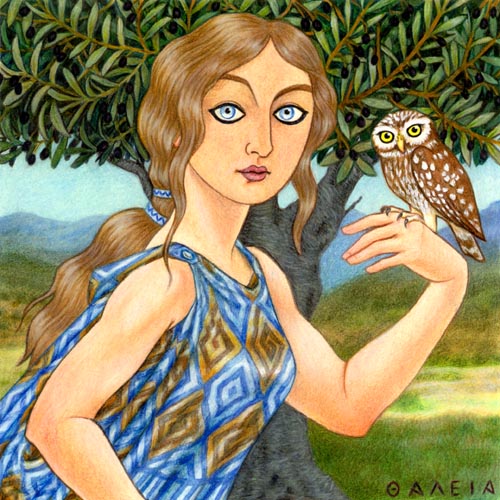 |
"Glaukopis" according to the search
engine Google
|
"Glaukos is the most prominent colour term associated with Athena…
as well as being one of Athena’s most common epithets, is also one of the most
intriguing, open as it is to a variety of interpretations and translations.” (Deacy and Villing. Journal of Hellenic Studies.
129, p.121)
From the above quotation it is clear that Glaukopis (ϒλανκώπις)cannot
easily be translated into English. Therefore I am not attempting here to answer
conclusively what glaukopis is, the various interpretations given and will
attempt to conclude with what may be the most likely.
Various academics have attempted to translate glaukopis to give a
certain colour to Athena’s eyes for example Leaf’s interpretation of
“blue-eyed” in 1900. Other colours have also been suggested, light blue, green
and even grey. The fact that academics cannot translate Glaukopis to a single
colour seems to suggest that Ancient Greek culture did not place as much
emphasis on the colour of eyes as descriptions as modern culture do. Many
academics now argue that glaukopis refers to the brightness or character of the
eyes. Even then there seems to be various translations, “flashing eyes,”
“glancing eyes,” “darting eyes” and “bright eyes.” Which one of these
characteristics may be considered correct?
One interesting interpretation put across by Day is to connect glaukopis
with Athena’s cunning and military prowess. Day supports this with Hymn 28.2
which reads “bright eyed and inventive.” This can be further supported by the
Iliad where she “flashing eyed” led Ares away from battle which resulted in a
Trojan defeat. (2010 p.144) The “flashing-eyed Athene” appears several times in
battle or preparation for battle in the Iliad, for example when Agamemnon
prepares for battle she appears “in their
midst” (Iliad 2.445). Perhaps in the context of battles the translations of
“darting-eyes” or “glancing-eyes”may have been better as it could be imagined
that constantly observing your surroundings would have been important in
battle. Appearing fearsome would have also been important in battle. Iliad
again “flashing-eyed” Athene appears next to Odyessus and insures the host
keeps quiet while he speaks, in another section she is accompanied by “Terror,
and Rout, and Discord” as she urges the Greeks to fight. (Iliad 4.435-450)
Athena's connection to the battlefield is further supported by Hesiod's description
of her birth as "bright-eyed Tritogeneia...the queen, who delights in
tumults and wars and battles." (Hesiod. Theogony. 920-925)
In further connection to the translation of Glaukopis as “flashing eyed”
could be in connection to it being derived from a verb which meant “to shine”
or “to burn.”(Luyster.History of Religion Vol. 5 No.1) This would also explain
how Athena’s Glaukopis could be frightening as it had the potential to be
fatal.
Although it could be argued that “flashing-eyed Athena” does not appear
in person in later dated documents her influence in deciding battles could
still be argued. In Aristophanes’s Wasps participants after a battle thank the
gods, but “before the battle an owl had
flown over our army.” (Aristophanes, Wasps.1085). Although it was common to
make predictions over the flight of birds, the fact an owl was particularly
identified may suggest a link to Athena. Such a link could be strengthened in
another work of Aristophanes, Knights
where a sausage seller sees Athena in a dream with an owl preached upon her
helmet. (Aristophanes. Knights. 1060) Athena’s owl can be more closely
connected to her through its connections to Glaukopis. This is seen by
the fact that it was called the Glaux (ϒλανξ). It has been pointed out by Leaf
and Luyster that Glaukopis could also be translated as “owl-eyed.” As with
Athena, the Glaux’s eyes were also seen as fatal as a statue of one on top of
Athena was said to attract birds and then kill them.
In Conclusion to this section it could be argued that an English
translation of Glaukopis is closely connected to another aspect of Athena. What
aspect that is depends on the academic translating it or on the context. Many
have felt that assigning a colour to it appropriate while others (or the same
academics) have also stated that Glaukopis relates more closely to a character
of the eyes as opposed to colour. Day has gone further and connected the
character of eyes of the character of Athena herself as fearsome. This is not
forgetting the same character of eyes being attributed to her owl, which some
have interpreted as the other way round, hence “owl-eyed Athena.”
Bibliogragphy
1. Day, Joseph W. Archaic Greek Epigram and Dedication: Representation and Reperformance.Cambridge University Press. 2010
2. Deary and Villing. “What was the colour of Athena’s aegis?” Journal of Hellenic Studies. 129 pp.111-129
3. Homer, The Iliad
4. Hesiod, Theogony
5. Leaf, Walter Commentary on the Iliad (1900)
6. Luyster, Robert. “Symbolic Elements in the Cult of Athena” History of Religions Vol.5. No.1 Summer 1965 pp.133-163
7. Morford, Mark P.D, Lenardon, Robert J. Classical Mythology 6th Edition Oxford University Press 1999
No comments:
Post a Comment